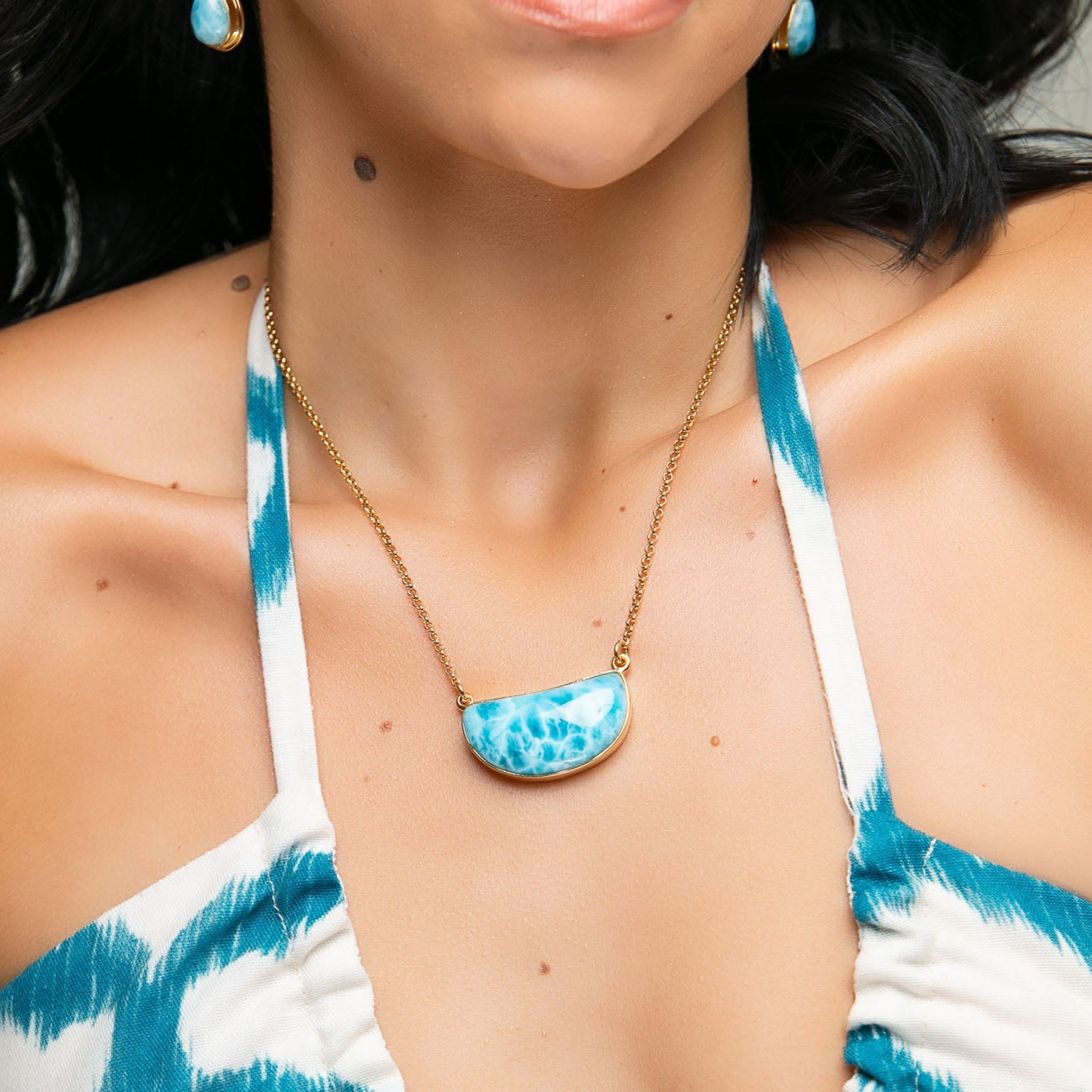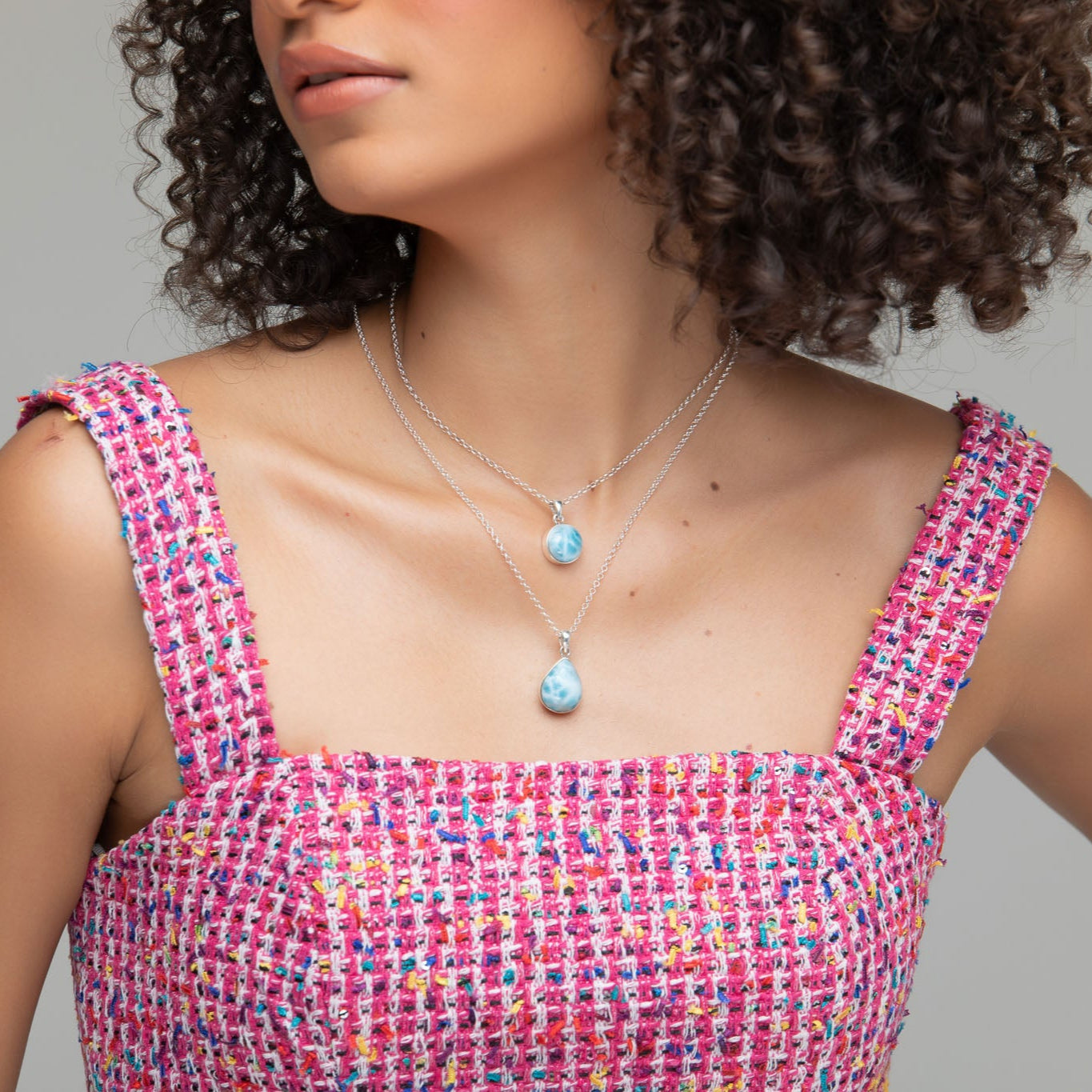The Allure of Larimar
For many visitors to the Dominican Republic, Larimar is one of the most memorable discoveries of their trip. Its soothing blue tones, reminiscent of the Caribbean Sea, immediately catch the eye. For Dominicans, Larimar is more than a beautiful gemstone—it is a symbol of place, identity, and the natural richness of the island.
Over time, this single stone has gathered many different names, stories, and associations. Understanding these names offers a window into how Larimar is perceived both locally and around the world.
Early Local Names and First Encounters
Long before Larimar became known internationally, locals in the Barahona region referred to it simply as “Piedra Azul”, meaning “Blue Stone” in Spanish. Pieces would occasionally be found in riverbeds, carried downstream from the mountains. The unusual color and natural beauty of the stone attracted attention, even when its exact origin was not yet understood.
Stories and informal accounts tell of local people collecting and appreciating the stone for its appearance, long before it entered the formal gemstone trade. In this early stage, Larimar was part of a local landscape, admired but not yet widely commercialized.
The Modern Discovery and the Name “Larimar”
The modern chapter of Larimar began in 1974, when Dominican Miguel Méndez and Peace Corps volunteer Norman Rilling are credited with rediscovering the source of the stone in the mountains of Barahona. When it came time to give it a distinctive name, Méndez combined the name of his daughter, Larissa, with the Spanish word for sea, “mar”. The result was “Larimar”—a name that captures both the personal story and the maritime character suggested by its colors.
This new name allowed the stone to be presented to international markets as something unique and clearly connected to the Dominican Republic and the Caribbean.
“The Blue Jewel of the Caribbean”
As Larimar became better known, it was frequently described as “The Blue Jewel of the Caribbean”. This phrase is not a technical term, but a poetic way of expressing the strong link between the stone and its place of origin.
On a symbolic level, the nickname reflects several ideas:
- The stone’s resemblance to the colors of Caribbean waters.
- Its exclusivity to one region of the Dominican Republic.
- Its role as a natural treasure that visitors and locals alike are proud of.
For many people, owning Larimar means carrying a small piece of the Caribbean with them, wherever they go.
Other Names and Synonyms Around the World
Over the years, Larimar has acquired a range of alternative names and descriptors in different markets. Some are commercial, some poetic, and some are rooted in spiritual or metaphysical traditions. Among them:
“Atlantis Stone”
Larimar is sometimes marketed as the “Atlantis Stone”. This name is linked to modern spiritual and esoteric beliefs that associate the stone with the mythical lost city of Atlantis. While there is no historical or scientific evidence to connect Larimar with Atlantis, the imagery of an underwater civilization and a blue stone has proven appealing in certain circles. It is important to distinguish between legend and fact: the stone itself is very real and comes from specific volcanic deposits in the Dominican Republic.
“Dolphin Stone”
Another nickname occasionally used is “Dolphin Stone”. This label plays on the association between Larimar’s blue tones and the sea, and the symbolic connection some people make between dolphins and harmony, communication, or freedom. Again, this is more of a poetic or metaphysical name rather than a mineralogical term.
“Stefilia’s Stone”
In some mineralogical and metaphysical contexts, Larimar has also been referred to as “Stefilia’s Stone”. The origin of this name is less widely known, but it appears in certain gem and crystal references as an alternative name for Larimar. Despite these variations, “Larimar” remains the most widely recognized term in both the jewelry trade and among collectors.
“Dominican Turquoise” (and Why It Is Not Turquoise)
Informally, some people have called Larimar “Dominican Turquoise” because of its blue color. However, Larimar is not related to turquoise mineralogically. Turquoise is a copper aluminum phosphate, whereas Larimar is a sodium calcium silicate (pectolite). Using accurate terminology is important so that buyers understand exactly what they are purchasing.
Larimar in Dominican Culture
Within the Dominican Republic, Larimar represents a tangible expression of local geology and craftsmanship. Artisans cut, polish, and set the stone into jewelry that ranges from simple, everyday pieces to highly elaborate designs. The stone appears in markets, boutiques, and specialized workshops, connecting tourism with artisan work.
For many Dominicans, Larimar is a symbol of national pride. It is one of the few gemstones in the world so closely linked to a single country, and it offers a way to share a part of the island’s natural beauty with visitors who want to take home something authentic.
Larimar in Contemporary Jewelry
Beyond its local significance, Larimar has gained an international following. Jewelry designers appreciate its versatility: it can be paired with sterling silver for a fresh, casual look, or with gold vermeil and other fine materials for more sophisticated designs.
Because each stone has its own pattern and shade, Larimar lends itself naturally to one-of-a-kind pieces. No two pendants, rings, or bracelets are exactly the same, which appeals to clients who value individuality in their jewelry.
Myths, Marketing, and Reality
The variety of names associated with Larimar—Atlantis Stone, Dolphin Stone, Blue Stone of the Caribbean—shows how strongly people respond to the gem’s appearance and origin. At the same time, it is important to balance poetic or spiritual narratives with accurate information.
The reality is already remarkable: Larimar is a rare blue pectolite found in a single region of the Dominican Republic, formed through specific volcanic and geological processes. Knowing this does not diminish its mystery; it simply grounds the story in the natural history of the island.
Why Larimar Matters to Collectors and Travelers
For collectors, Larimar represents a gem with a clear, defined geographic source and limited availability. For travelers, it is a meaningful reminder of time spent in the Dominican Republic. For locals and artisans, it is a material that connects geology, history, and work.
Whether it is called Larimar, Atlantis Stone, or the Blue Jewel of the Caribbean, the stone’s enduring appeal lies in its combination of beauty, rarity, and sense of place.
Continue Exploring Larimar
If you would like to learn more about the scientific aspects of Larimar—its mineral composition, formation, colors, and quality factors—read our complementary article: Larimar Stone: Important Info & Facts.






1 comment
Which color is worth more?
The darker or the lighter?
Leave a comment